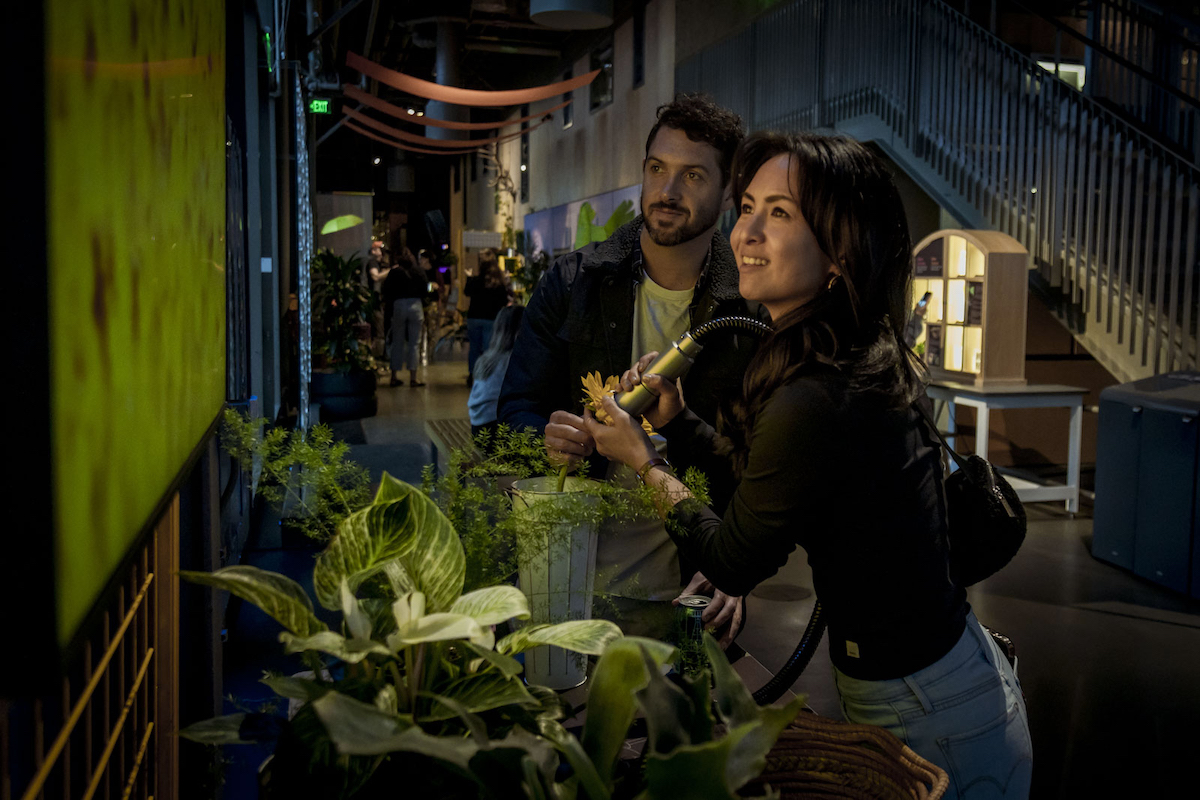Plants: we eat them, wear them, live, work, and play in buildings made from them, and decorate those same buildings with yet more plants. For many, plants are a mere resource, but the world’s flora has deep roots, shaping every culture––histories forgotten by some and honored by others. Both fun and thought-provoking, ¡Plantásticas! Our Lives with Plants, a temporary exhibition at the Exploratorium in San Francisco, explores the myriad relationships between people and plants, with a special focus on Latinx and Indigenous perspectives.
At the heart of the exhibit grows a verdant and colorful temporary garden, created by artist and plant shop owner Andi Xoch and inspired by front-yard and community gardens in Boyle Heights, her predominantly Latinx neighborhood in Los Angeles. Xoch’s garden can feel like a place of respite, even in the middle of a busy museum. The lush and brightly colored space welcomes visitors without dictating their use of the space. Both real and plastic plants envelop visitors in the garden, emerging from brightly colored pots, repurposed kiddie pools, wicker baskets, car tires, and a 110-ounce hominy can, all resting atop a floor of artificial grass. She draws on rasquachismo, an aesthetic of the Chicano art movement in the 1960s and ’70s that she describes as “rooted in resourcefulness…The idea is to create something of beauty through fervent ingenuity.”
The museum worked to meaningfully involve Latinx and Indigenous communities in the development of the exhibition, say curators Kevin Boyd and Sarah Seiter. Workshops with community members helped define the exhibition’s parameters and goals. Together, everyone determined it should “emphasize the intergenerational passing of knowledge about plants” and “stress the importance of plants to people’s identities.” These principles are captured in short videos featuring Vincent Medina and Louis Trevino, who explain the roles of plants in their respective Ohlone tribes in the Bay Area. In one video, Trevino demonstrates the processing of valley oak acorns to make acorn bread, which elder Dolores Dario Galvan Lameira describes as a “bread of life.” In another, Medina discusses the importance in East Bay Ohlone culture of respecting the personhood of plants and calling them by their original names—miryan for sage, hawwen for manzanita, hiišen for mugwort.
Community member suggestions led to a theme of multisensory learning, including the connection between smell and memory. A mortar holding dried and crushed plants presents that idea, and one plant on offer is bay laurel (sokóote in Chochenyo Ohlone). Sokóote serves a range of ceremonial, culinary, and medical purposes for Ohlone people, from a delicacy of its fruits and nuts to playing with “stick-dice” made from its wood, explains text by Medina and Trevino, who were involved throughout the exhibition planning process. Other visitors may associate the smell with hikes along the Northern California coast or foods that use the leaves of sokóote’s distant Mediterranean cousin, sweet bay leaf. Whatever one’s background, some of the plant scents are likely to evoke cherished memories and meanings.

¡Plantásticas! also features more science-focused interactive exhibits. High-powered microscopes provide a glimpse into the amazing world of a living Arabidopsis plant and 20 varieties of maize—ch’ullpi, lavender clay, Hopi turquoise, atomic orange, and more—in exquisite detail. And there’s a silly, kid-friendly video in which animated images of stomata (pores in leaves that are sometimes likened to mouths) sing a parody version of Queen’s “Bohemian Rhapsody” in English and Luis Fonsi’s “Despacito” in Spanish.
But plants as scientific objects and plants as cultural and ethical subjects aren’t presented as oppositional ways of relating to this kingdom of life. One display encourages visitors to touch the leaves of mimosa plants and see what happens. The leaves should close up, but the display wording also cautions that if they do not, the plant may be overstimulated and that another plant should be tried. Though a subtle gesture, this display suggests that we have responsibility to plants. Across the diverse array of displays a unifying theme emerges: “[there are] different ways of knowing plants and engaging with plants,” says Seiter, and “each of them brings different color to the picture of your relationship with plants.”





